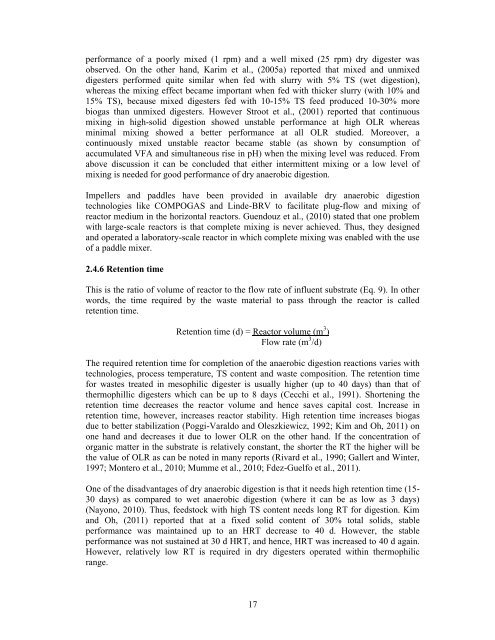dry anaerobic digestion of municipal solid waste and digestate ...
dry anaerobic digestion of municipal solid waste and digestate ...
dry anaerobic digestion of municipal solid waste and digestate ...
Create successful ePaper yourself
Turn your PDF publications into a flip-book with our unique Google optimized e-Paper software.
performance <strong>of</strong> a poorly mixed (1 rpm) <strong>and</strong> a well mixed (25 rpm) <strong>dry</strong> digester was<br />
observed. On the other h<strong>and</strong>, Karim et al., (2005a ) reported that mixed <strong>and</strong> unmixed<br />
digesters performed quite similar when fed with slurry with 5% TS (wet <strong>digestion</strong>),<br />
whereas the mixing effect became important when fed with thicker slurry (with 10% <strong>and</strong><br />
15% TS), because mixed digesters fed with 10-15% TS feed produced 10-30% more<br />
biogas than unmixed digesters. However Stroot et al., (2001) reported that continuous<br />
mixing in high-<strong>solid</strong> <strong>digestion</strong> showed unstable performance at high OLR whereas<br />
minimal mixing showed a better performance at all OLR studied. Moreover, a<br />
continuously mixed unstable reactor became stable (as shown by consumption <strong>of</strong><br />
accumulated VFA <strong>and</strong> simultaneous rise in pH) when the mixing level was reduced. From<br />
above discussion it can be concluded that either intermittent mixing or a low level <strong>of</strong><br />
mixing is needed for good performance <strong>of</strong> <strong>dry</strong> <strong>anaerobic</strong> <strong>digestion</strong>.<br />
Impellers <strong>and</strong> paddles have been provided in available <strong>dry</strong> <strong>anaerobic</strong> <strong>digestion</strong><br />
technologies like COMPOGAS <strong>and</strong> Linde-BRV to facilitate plug-flow <strong>and</strong> mixing <strong>of</strong><br />
reactor medium in the horizontal reactors. Guendouz et al., (2010) stated that one problem<br />
with large-scale reactors is that complete mixing is never achieved. Thus, they designed<br />
<strong>and</strong> operated a laboratory-scale reactor in which complete mixing was enabled with the use<br />
<strong>of</strong> a paddle mixer.<br />
2.4.6 Retention time<br />
This is the ratio <strong>of</strong> volume <strong>of</strong> reactor to the flow rate <strong>of</strong> influent substrate (Eq. 9). In other<br />
words, the time required by the <strong>waste</strong> material to pass through the reactor is called<br />
retention time.<br />
Retention time (d) = Reactor volume (m 3 )<br />
Flow rate (m 3 /d)<br />
The required retention time for completion <strong>of</strong> the <strong>anaerobic</strong> <strong>digestion</strong> reactions varies with<br />
technologies, process temperature, TS content <strong>and</strong> <strong>waste</strong> composition. The retention time<br />
for <strong>waste</strong>s treated in mesophilic digester is usually higher (up to 40 days) than that <strong>of</strong><br />
thermophillic digesters which can be up to 8 days (Cecchi et al., 1991) . Shortening the<br />
retention time decreases the reactor volume <strong>and</strong> hence saves capital cost. Increase in<br />
retention time, however, increases reactor stability. High retention time increases biogas<br />
due to better stabilization (Poggi-Varaldo <strong>and</strong> Oleszkiewicz, 1992; Kim <strong>and</strong> Oh, 2011) on<br />
one h<strong>and</strong> <strong>and</strong> decreases it due to lower OLR on the other h<strong>and</strong>. If the concentration <strong>of</strong><br />
organic matter in the substrate is relatively constant, the shorter the RT the higher will be<br />
the value <strong>of</strong> OLR as can be noted in many reports (Rivard et al., 1990; Gallert <strong>and</strong> Winter,<br />
1997; Montero et al., 2010; Mumme et al., 2010; Fdez-Guelfo et al., 2011).<br />
One <strong>of</strong> the disadvantages <strong>of</strong> <strong>dry</strong> <strong>anaerobic</strong> <strong>digestion</strong> is that it needs high retention time (15-<br />
30 days) as compared to wet <strong>anaerobic</strong> <strong>digestion</strong> (where it can be as low as 3 days)<br />
(Nayono, 2010). Thus, feedstock with high TS content needs long RT for <strong>digestion</strong>. Kim<br />
<strong>and</strong> Oh, (2011) reported that a t a fixed <strong>solid</strong> content <strong>of</strong> 30% total <strong>solid</strong>s, stable<br />
performance was maintained up to an HRT decrease to 40 d. However, the stable<br />
performance was not sustained at 30 d HRT, <strong>and</strong> hence, HRT was increased to 40 d again.<br />
However, relatively low RT is required in <strong>dry</strong> digesters operated within thermophilic<br />
range.<br />
17

















